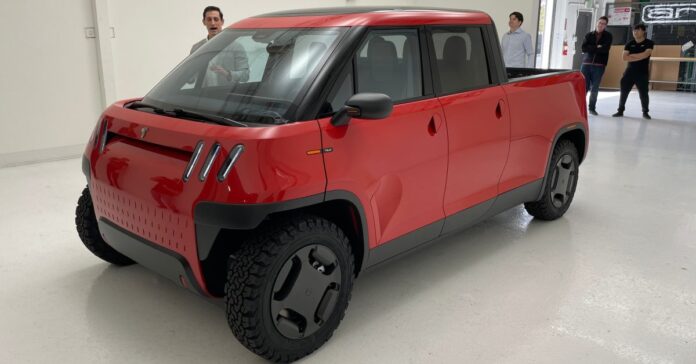TELO gave us an exclusive opportunity to get up close and personal with a pre-production version of its tiny electric truck, slated to ship its first units in about a year.
We first learned about TELO back in 2023, when the company announced it was planning to build an electric truck the size of a Mini but with a bed the size of a Hummer’s.
it sounds impossible, but there’s a lot of wasted space in vehicle designs these days, especially trucks where automakers consider an enormous front hood as an important part of design (despite the inherent deadliness of this design decision).
TELO went another direction, focusing on a truck with maximum utility and minimum footprint – and says it will be able to offer utility on par with today’s mid-size pickup trucks like the Toyota Tacoma, but in a package that’s only 152 inches long (for comparison, tiny Japanese kei cars are 134 inches long maximum).
Now, less than two years later, TELO has completed its first full pre-production driveable vehicle, and we were invited out to have a look and take a ride. Previously, TELO had only made a design mule and a go kart-like chassis, but now it’s got something that actually looks like a real car (and includes the recent design/aero changes from when the truck got its configurator and $41k base price).
The design changes are mainly aerodynamic, including a more rounded roofline and moving the “pill” design element near the front wheel well, where it now helps airflow around the exposed front wheel, reducing turbulence. TELO says it was able to improve aerodynamics significantly through the use of CFD aerodynamic optimization software, saving on expensive wind tunnel time.
But we also got a first look at some features we hadn’t seen before.
For example, the mid-gate. The bed is normally 62 inches long and 49 inches wide (between the wheel arches, so you can fit a sheet of plywood), but when folding down the rear seats, that gets extended even further. The bed is also covered with L-tracks all around, making it easy to tie down gear.
That said, we’ve seen a lot of truck prototypes that promise a mid-gate, and then they don’t end up on the production vehicle. So we’ll put an asterisk on that feature for now.
And note: that bed is half a foot longer than the bed of a Rivian R1T and the same size as a Hummer EV’s bed, despite TELO being nothing close to the size of those trucks.
Another neat storage feature is one that seems to have been cribbed from Rivian’s “gear tunnel,” a long, lockable storage space underneath the bed and the passenger compartment which is useful for dirty gear that you don’t want to bring inside the cab, but don’t want to leave in the bed. TELO has a similar (but smaller) space, which it dubs the “monster tunnel” – because, like a monster, it’s… under the bed (hiyoooooo!).
On the interior, there isn’t exactly a lot of space, but there’s enough for normal-sized people – and even abnormally-sized ones. One of the journalists in attendance was 6’10”, and he said “I fit fine.”
Both front and rear seats had plenty of headroom and good foot room, owing to the floating seat design which allows rear seat passengers to put their feet under the front seat.
The knee room was perhaps a slight limitation, especially on rear seat ingress, as the door aperture is taller and more narrow than most. Same with the driver seat, my knees could have had a little more room, but we didn’t get a chance to fiddle with seat and steering wheel adjustments, so this is probably a solvable problem.
And while we didn’t sit inside the truck for long, it’s certainly no less comfortable than other working vehicles we’ve tried (step vans, box trucks and so on) despite being a fraction of the overall size.
The cockpit area includes a wide center touchscreen and several gauges in the driver instrument cluster, though none of this was anywhere near final (edit: for example, seeing the vehicle again a couple days later, a physical knob had been added to the touchscreen which wasn’t there before). Some were static screens, some could be interacted with via remote, but the touchscreen wasn’t working yet.
Then, I got the chance to be the first journalist to ever take a ride in TELO’s pre-production vehicle.
It was just a quick ride around the block in the industrial part of town, but it proved that this isn’t just a design project.
TELO says the truck will have options for either a 300hp single motor or 500hp dual motor configuration. While the truck we rode in had two motors, they were limited to 40% of power for the time being. So the truck got around fine, but nothing exceptional.
The next question is whether a tiny truck even needs 500hp to begin with, but that can wait for another day – perhaps until we’re able to put it to payload/towing tests. TELO says it has a payload capacity of 1,600lbs and towing capacity of 6,600lbs.
TELO also could branch out into offering some sort of off-road package, and pointed out its nearly 90º approach angle, given that the front tires go all the way up to the very front of the vehicle.
And here you can hear the wonderful quiet of electric mobility… before any sort of dumb noisemakers get added and spoil the fun:
The truck is so small that I didn’t really have to step back or zoom out in order to capture it all in frame
Despite being small, the truck is still rather hefty with a 4,400lb curb weight, regardless of battery option (the larger option uses newer, denser cells to pack more energy in a similar weight). This is still thousands of pounds less than other electric trucks (~6-7k lbs), but (understandably) quite a bit more than the Mini SE (~3,200lbs), and even not far off from the Toyota Tacoma (~4,500lb) to which TELO compares itself.
Speaking of that comparison – the TELO truck is a full five feet shorter than the “compact” Toyota Tacoma or four feet shorter than the Maverick, to say nothing of other enormous vehicles in the US. TELO gave us a live demo of what the truck looks like next to both a Mini Cooper SE and a full size RAM 2500 pickup.
This really underlines how much of our space we’ve given up for something that doesn’t really offer a whole lot more utility (that you probably won’t use anyway). And how many of our lives we’re giving up for those pedestrian-murdering truck front ends.
Because, as trucks and SUVs keep getting larger, and automakers keep pushing more and more people into them, and emissions and pedestrian deaths keep rising, the US desperately needs more small vehicles – and needs a company that will actually try to sell them, instead of ignoring they exist and pushing people towards bigger.
So we here at Electrek are quite excited for what this TELO truck represents – finally, the advent of a reasonably sized utility vehicle. They’re available in Europe, they’re available in Japan… but this would be the first available here, at least in a very long time.
TELO offers a really compelling argument here: a vehicle that’s capable but isn’t impossible to park, isn’t excessive in terms of material inputs, and doesn’t contribute to the ever-rising plague of pedestrian deaths from oversized vehicles. If you occasionally want a truck for truck things, but otherwise want an efficient vehicle that actually fits places, this seems like a good option.
TELO has many modular configurations in mind, including a “mini-SUV,” and potentially a third row in the bed – if it can get past homologation.
And TELO’s $41k base price (before incentives) and 260 miles of range compare favorably to the most popular commercial EV: Ford’s E-Transit, with an 89kWh battery, 159 mile range and $51k base price (which is now the same as the gas version). That’s a much larger vehicle, but for a company that doesn’t need that much space but still wants to do intra-city deliveries, tradesman work, etc., this could be a great option
All in all, despite TELO not being all that old of a company (or that large – it only has 11 employees to date, with one cofounder being Forrest North, an early Tesla employee, and the board including Marc Tarpenning, a Tesla founder), it has produced a pretty neat vehicle which seemed pretty well put together – at least for the few minutes we got to ride in it.
It’s an important milestone given that TELO has said it wants to ship its first vehicles by the end of this year (although that date might be slipping, more recently the company has been saying “2026” – which could mean the start, or the end, of the year). That’s a very close timeline – though it’s only expecting a small initial batch at first, and will do so through contract manufacturing, which keeps startup costs low.
You may remember another EV startup that used contract manufacturing – Fisker. That didn’t go so well, but one thing Fisker did do was come out almost on time (it was unveiled in 2020 with a 2022 release date, and the first Ocean was delivered in May 2023 – a pretty tight timeline, as far as car manufacturing goes). So, hopefully TELO doesn’t let its timeline slip too much here.
I still think it’s optimistic that this truck will ship on the timelines TELO has stated, because there is still a lot to be done before this truck is production ready. But TELO is at least not overstating its volume ambitions. It only expects to ship in very limited numbers at first, and will scale manufactuirng later through its contract manufacturing process. Though it hasn’t yet announced a volume production partner, it says it’s in discussions with several different well-known manufacturers, and we’ll learn more about which one they’re working with once ink hits paper.
You can view the TELO configurator here, where you can also make a $152 refundable reservation (the same as the length of the vehicle in inches). TELO says it has 5,000 reservations already – up 1,300 from the last time we checked in December.
Charge your electric vehicle at home using rooftop solar panels. Find a reliable and competitively priced solar installer near you on EnergySage, for free. They have pre-vetted installers competing for your business, ensuring high-quality solutions and 20-30% savings. It’s free, with no sales calls until you choose an installer. Compare personalized solar quotes online and receive guidance from unbiased Energy Advisers. Get started here. – ad*


